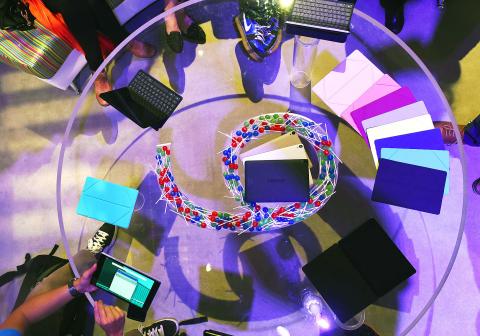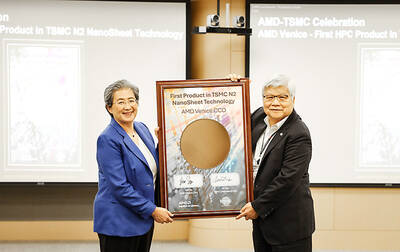Smartphone maker HTC Corp (宏達電) yesterday announced a strategic partnership with US sportswear and accessories company Under Armour Inc in a bid to enter the wearable device market.
HTC chief executive officer Peter Chou (周永明) said the firm plans to launch an array of new products later this year.
“It’s an incredibly exciting new direction for us,” Chou said, adding that the company would work closely with Under Armour to provide consumers with a range of connected health and fitness products and services.

Photo: AFP
Chou said the firm is working with UA Record — a health and fitness network launched by Under Armour — to ensure the shared efforts will meet the highest expectations of athletes everywhere.
Under Armour Connected Fitness senior vice president Robin Thurston said HTC’s fearless commitment to innovation, and its attention to detail and premium design, make it an ideal partner for the US company.
“The partnership will allow athletes to take their performance to the next level in a more connected and intuitive way,” Thurston said in a press statement.
Yuanta Securities Investment Consulting Co (元大投顧) analyst Jeff Pu (蒲得宇) said that for the past year, HTC has been looking for new business opportunities outside the smartphone segment.
“HTC cannot win by relying solely on its smartphone segment because the industry is too competitive,” Pu said by telephone.
He added that most of the health and fitness wearable products in the market are simple-designed smart wristbands and HTC would face a limited market if it aims to offer more sophisticated designs.
HTC yesterday also launched its new Nexus 9 tablet with 4G long-term evolution (LTE) connectivity in Taiwan. The product will be available from Friday at HTC’s VIP stores and from local telecoms, the company said.
Pu was cautious about potential sales contributions from the Google Inc cobranded product.
With the tablet industry declining and prices falling, it will be hard for HTC to secure a position in the market, he said.
Unlike the past few years, the global tablet market is unlikely to witness explosive growth this year because of high penetration rates, Gartner said in a report on Monday.
Worldwide tablet shipments are forecast to reach 233 million units this year, an 8 percent increase from last year, when the tablet market grew 4.3 percent to 207 million units, Gartner said.
Ranjit Atwal, a research director at Gartner, attributed the slowdown in shipment growth last year to the lifetime of tablets being extended.
“They are shared out amongst family members and software upgrades, especially for iOS devices, keep the tablets current,” Atwal wrote in a report. “Another factor includes the lack of innovation in hardware which refrains consumers from upgrading.”
HTC also unveiled a new low-end smartphone, the dual SIM card Desire 620G, in Taiwan. Priced at NT$4,990 (US$156), the handset comes with a 5-megapixel front camera and 8-megapixel rear camera.
The firm has said that it aims to secure positions in all market segments — from high to low-end — in Taiwan this year.
Citigroup Global Markets praised HTC’s strategy, saying it is good for the company to tackle the low-end segment.
“We foresee smartphone shipments in this quarter to grow 36 percent year-on-year, driven by HTC’s low-end Desire line and its upcoming flagship product,” Citigroup analyst Dennis Chan (詹宗勳) said in a client note released on Tuesday.
Pu also said he expects HTC’s performance this year would be less volatile as the firm spreads its risks with better product lines.

UNCERTAINTY: Innolux activated a stringent supply chain management mechanism, as it did during the COVID-19 pandemic, to ensure optimal inventory levels for customers Flat-panel display makers AUO Corp (友達) and Innolux Corp (群創) yesterday said that about 12 to 20 percent of their display business is at risk of potential US tariffs and that they would relocate production or shipment destinations to mitigate the levies’ effects. US tariffs would have a direct impact of US$200 million on AUO’s revenue, company chairman Paul Peng (彭雙浪) told reporters on the sidelines of the Touch Taiwan trade show in Taipei yesterday. That would make up about 12 percent of the company’s overall revenue. To cope with the tariff uncertainty, AUO plans to allocate its production to manufacturing facilities in

TAKING STOCK: A Taiwanese cookware firm in Vietnam urged customers to assess inventory or place orders early so shipments can reach the US while tariffs are paused Taiwanese businesses in Vietnam are exploring alternatives after the White House imposed a 46 percent import duty on Vietnamese goods, following US President Donald Trump’s announcement of “reciprocal” tariffs on the US’ trading partners. Lo Shih-liang (羅世良), chairman of Brico Industry Co (裕茂工業), a Taiwanese company that manufactures cast iron cookware and stove components in Vietnam, said that more than 40 percent of his business was tied to the US market, describing the constant US policy shifts as an emotional roller coaster. “I work during the day and stay up all night watching the news. I’ve been following US news until 3am

COLLABORATION: Given Taiwan’s key position in global supply chains, the US firm is discussing strategies with local partners and clients to deal with global uncertainties Advanced Micro Devices Inc (AMD) yesterday said it is meeting with local ecosystem partners, including Taiwan Semiconductor Manufacturing Co (TSMC, 台積電), to discuss strategies, including long-term manufacturing, to navigate uncertainties such as US tariffs, as Taiwan occupies an important position in global supply chains. AMD chief executive officer Lisa Su (蘇姿丰) told reporters that Taiwan is an important part of the chip designer’s ecosystem and she is discussing with partners and customers in Taiwan to forge strong collaborations on different areas during this critical period. AMD has just become the first artificial-intelligence (AI) server chip customer of TSMC to utilize its advanced

Six years ago, LVMH’s billionaire CEO Bernard Arnault and US President Donald Trump cut the blue ribbon on a factory in rural Texas that would make designer handbags for Louis Vuitton, one of the world’s best-known luxury brands. However, since the high-profile opening, the factory has faced a host of problems limiting production, 11 former Louis Vuitton employees said. The site has consistently ranked among the worst-performing for Louis Vuitton globally, “significantly” underperforming other facilities, said three former Louis Vuitton workers and a senior industry source, who cited internal rankings shared with staff. The plant’s problems — which have not